Isabela Tapia Hernandez
The Collections Care Assistant role was created for our students to explore the cultural heritage sector through employment and support their career aspirations post-graduation.
This is the second of three blog posts detailing their time with us!
I’m Isabela, and I am currently completing a Masters by Research in Collections and Curating Practices at the University of Edinburgh. In this blog post, I will reflect on my journey as a student working with Heritage Collections, sharing some of the projects I worked on and the insights I gained during this enriching experience. Through hands-on work, navigating complex cataloguing systems, and participating in meticulous housekeeping across various University facilities, I’ve gained a comprehensive understanding of both the practical and strategic aspects of preserving and managing cultural artefacts.
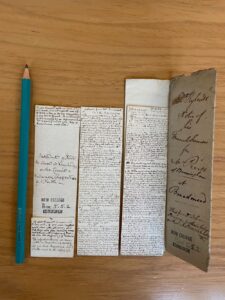
A pencil for reference next to the tiniest handwritten sermon, consisting of three folded papers titled ‘Dr Rylands Notes of his Funeral Sermon for Mr Peorch of Birmingham of Broadmead’
On my first day at New College, I helped rehouse the Thomas Chalmers’ collection of manuscripts. It was an incredible introduction to the University’s historic collections: I not only held the last written letter of John Renwick, one of the last Covenanter to be executed in 1682, but also an autograph of Woodrow Wilson sent to Edinburgh during his trip to sign the Treaty of Versailles in 1919. I even encountered the tiniest handwriting I’ve ever seen in a sermon from the 1790s! These remarkable artefacts marked the beginning of my journey and set the tone for the dynamic and varied nature of my work.
Shortly after, I was introduced to what was to become my main project for this role: the barcoding of the Musical Instrument Collection. This project involved inventorying and re-labelling the brass instruments in storage with a new system of barcode labels to replace the old hand-written ones.
I worked closely with the staff of St Cecilia Hall, specifically with Jonathan Santa Maria Bouquet (Senior Conservator), Hannah Chalmers (Museum Assistant), and Jenny Nex (Musical Instrument Curator). I spent my first days in St Cecilia’s Hall, where I met the rest of the lovely museum team and was set up and introduced to Vernon, the collections management system. Once I was given the green light, I started going into the storage room where the fun began!
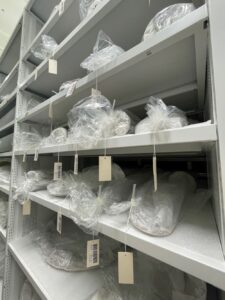
Instruments in storage with new labels hanging out.
The barcoding project was no small task. It included inventorying the objects, ensuring the state of the housing (packaging and location), and checking that the instruments were in good condition. I logged onto a separate spreadsheet some of the issues I encountered. Initially progress was going smoothly until I encountered a notable hurdle on one of the shelves: twelve boxes, each the size of a shoe box, filled with an average of 50 items—all brass mouthpieces! This is where I tested my love for the art of caring for collections, as it felt like a never-ending amount of objects stashed in the same spot! After weeks of work, I was proud and satisfied for how well-organized and neat these boxes now look.
To date, I have generated over a thousand barcodes for as many items. I am genuinely pleased that my efforts will benefit future researchers and users of musical instruments alike.
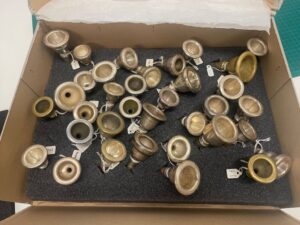
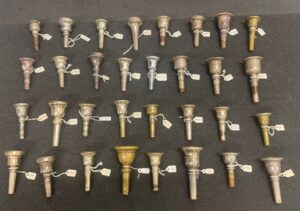
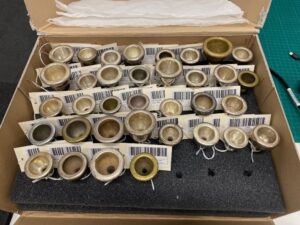
Part of the process of re-labelling involves inventorying, rehousing when needed, and of course, creating and adding the new barcodes!
I can’t thank Jenny Nex enough for her incredible patience whenever I had to ask about bits and pieces from brass instruments, which I didn’t know how to label at the time. Now, I’ll always know what a ‘crook’, a ‘bit’, and a ‘shank’ are, but please don’t test me on them!
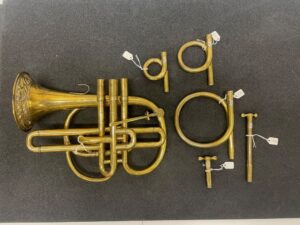
Brass instrument with crooks and shanks.
Throughout my amazing experience, I also had some time away from storage to get to know other people’s roles and projects. Besides attending the Conservation and Collections Management scheduled meetings, which were great opportunities to catch up on all of our colleagues’ work, I visited the University Collections Facilities. There, I helped with housekeeping and learned about other conservation projects. I also had the opportunity to shadow some of my fellow Collections Care Assistants and reciprocally share aspects of my own project with them. Additionally, I attended the ‘Material Culture Methodologies & the Edinburgh University Heritage Collections’ event, organised by the Material Cultures research cluster, which allowed me to learn about many other interesting objects held by the University. Finally, I visited Newhailes Estate as part of an intern exchange with the National Trust of Scotland, where we learned about the challenges in historic houses and their work on preventive conservation.
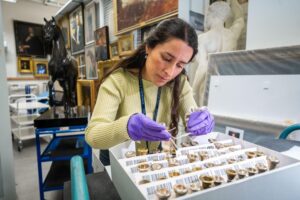
Organising mouthpieces back into their box.
In these last few weeks, I have come to realise how privileged I feel to have had this opportunity with the Heritage Collections. It has not only given me the chance to learn on the job but also to connect with and understand the roles behind every important area of the organisation. This experience has provided me with a solid foundation to build on. I am truly grateful to many colleagues who have openly shared their career paths with me; it has been inspiring to hear about their diverse backgrounds and journeys into heritage. I will miss being part of the amazing team at the Main Library and St Cecilia’s, but I leave with the certainty that our paths will cross again in the future.
Thank you all for such a welcoming atmosphere, tis been a good season!
Isabela
Student Collections Care Assistant
